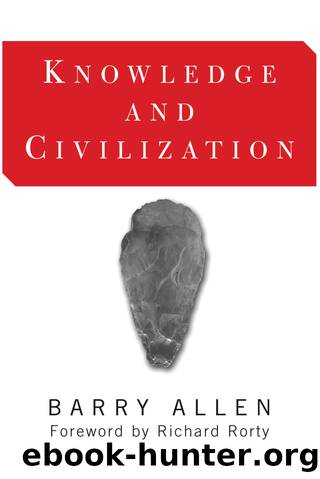Knowledge and Civilization by Barry Allen

Author:Barry Allen
Language: eng
Format: epub
Publisher: Routledge
Walking, Talking, Making Tools: Spandrels in Human Evolution
Three moments of human evolution have attracted a lot of thought: bipedalism, the first stone tools, and language. I want to discuss each, but first to establish a context. Steven Jay Gould gave a use in the theory of evolution to the architectural concept of a spandrel.54 In architecture, a spandrel is not something designed as such but comes into being as an elegant way to design structures with arches. Any structure using two or more adjacent arches (meeting at 90 or 180 degrees) inevitably generates a triangular space over the common edge (see figures 6.2 and 6.3). The spandrel is not merely the space as such but how it works in the structure. It may be a focus for ornamentation, and when appropriately designed can contribute to structural strength, for instance by dispersing stress concentrations from corners.
Building with arches gives you spandrels, at least potentially, even though no one builds with arches for the sake of making spandrels. Gould thinks the same thing happens in evolution, where he calls the process exaltation. Spandrel traits are not ad-apted, or selected for what they do, but are, potentially and contingently, adapted to functions for which they are recruited, or exapted, after the anatomical fact. Gould thinks spandrels are inevitable in evolution. Since "all organisms evolve as complex and interconnected wholes, not as loose alliances of separate parts, each independently optimized by natural selection," he infers that "any adaptive change must also generate, in addition, a set of spandrels, or nonadaptive byproducts."55
None of this would be news to Darwin, who never believed natural selection was the mechanism of evolution and even came to feel he had given it too much importance,56 Organic complexity is for him a broader category than adaptation, having different evolutionary causes, including sexual selection, inheritance of acquired characteristics, and spandrels, or what Darwin calls correlated variation. "In man, as in the lower animals, many structures are so intimately related, that when one part varies so does another, without our being able, in most cases, to assign any reason." Darwin specifically excludes natural selection. Since modifications of structure "may be wholly due to the laws of
Figure 6.2 The Spandrels of St. Steven's, Esztergom, Hungary. Author's photograph.
Download
This site does not store any files on its server. We only index and link to content provided by other sites. Please contact the content providers to delete copyright contents if any and email us, we'll remove relevant links or contents immediately.
The remains of the day by Kazuo Ishiguro(7551)
Tools of Titans by Timothy Ferriss(6949)
The Black Swan by Nassim Nicholas Taleb(6192)
Inner Engineering: A Yogi's Guide to Joy by Sadhguru(5897)
Giovanni's Room by James Baldwin(5879)
The Way of Zen by Alan W. Watts(5800)
The Six Wives Of Henry VIII (WOMEN IN HISTORY) by Fraser Antonia(4791)
The Power of Now: A Guide to Spiritual Enlightenment by Eckhart Tolle(4756)
Astrophysics for People in a Hurry by Neil DeGrasse Tyson(4620)
Asking the Right Questions: A Guide to Critical Thinking by M. Neil Browne & Stuart M. Keeley(4576)
12 Rules for Life by Jordan B. Peterson(3734)
The Ethical Slut by Janet W. Hardy(3504)
Skin in the Game by Nassim Nicholas Taleb(3462)
Housekeeping by Marilynne Robinson(3402)
The Art of Happiness by The Dalai Lama(3385)
Double Down (Diary of a Wimpy Kid Book 11) by Jeff Kinney(3274)
Skin in the Game: Hidden Asymmetries in Daily Life by Nassim Nicholas Taleb(3264)
Walking by Henry David Thoreau(3234)
12 Rules for Life: An Antidote to Chaos by Jordan B. Peterson(3204)
